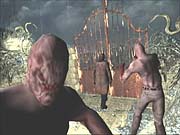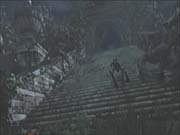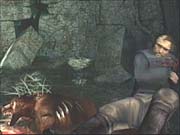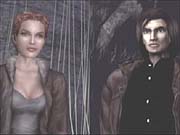Alone in the Dark: The New Nightmare Preview
We checked out the Dreamcast port of this upcoming survival-horror game.
With the veritable avalanche of survival-horror titles hitting the market these days, it's hard to remember that the originator of the genre has nothing to do with zombies or the Umbrella Corporation. Alone in the Dark was a trailblazer when it was released in 1993. It was the first game to feature 2D prerendered backgrounds with 3D polygonal characters and the horrific atmosphere that Capcom has nearly trampled into the ground with its Resident Evil series. Two mediocre sequels later, Alone in the Dark: The New Nightmare is looking to restore the series' once lofty reputation.

More thriller than horror, the Alone in the Dark franchise works on the premise that it's sometimes scarier to not know what's hiding in the shadows than to have armies of the undead swarming from every crevice. The main character from past Alone in the Dark games, Edward Carnby, has returned with a drastic makeover that makes him more closely resemble Brandon Lee in The Crow than the pencil-pushing private eye from the previous games in the series. Another playable character is along for the ride this time as well: Aline Cedrac, an archaeologist trying to uncover the true identity of her father, joins Edward on his quest. The New Nightmare is set on a gloomy piece of land called Shadow Island. It seems that Charles Fiske, one of Edward's associates, was found dead on Shadow Island while searching for three ancient tablets with mythical powers. Edward must solve the mystery of Fiske's death and discover the true meaning and power behind the tablets.
As The New Nightmare begins, you may choose to play as either Edward or Aline. Both characters begin their quest on different parts of the island, but their paths cross at several points, and the two can communicate with one another any time with a set of walkie-talkies. The two characters share the same adventure 40 percent of the time, but the remainder is unique to each. The storytelling techniques used in The New Nightmare are subtler than those found in other survival-horror titles. The beginning of Edward's game has him stumbling onto a scraggly character just outside a large mansion. The man insists that Edward turn around and head back, but being the headstrong person he is, Edward refuses. The shadowy figure then asks Edward for some bullets for his gun, and Edward obliges and then heads off on his quest. Moments later, a gunshot is heard. If Edward returns to the scene of his meeting with the man, he will find that he has committed suicide. It's this sort of unnerving, suspenseful situation that propels The New Nightmare more directly into the realm of a thriller than a hack-and-slash gorefest.

Edward begins his game with a pistol, though the most effective weapon when facing many of the island's monsters is his trusty flashlight. Merely illuminating many of the monsters on Shadow Island is more than enough to destroy them. Thankfully, Edward's flashlight never runs out of batteries, unless it's done for dramatic effect. There are seven weapons at Edward's disposal throughout the game, and an autolock feature similar to the one found in Capcom's Resident Evil series allows you to line up enemies and blast them without wrestling with the controls. Aline begins her game with no weapons at all. She is an archaeologist, so her scientific way of thinking causes her to solve problems in a more analytical fashion. Instead of blasting your way through the levels in the same manner you would with Edward, Aline's quest requires you to use more puzzle-solving skills and inductive reasoning.
There are three main areas in the game, including an outdoor area, a huge mansion, and a network of water-filled caverns. As you make your way through the darkened levels with the flashlight, items are discovered with the help of a blue sparkle that emanates from them. While there are still plenty of cranks to turn, keys to collect, and people to chat with, the relentless backtracking present in most modern survival-horror titles has been toned down quite a bit. Even so, you still have a notebook, an object list, and a document file that may be accessed by pressing start.

While the original Alone in the Dark was the first game to feature a hybrid of 2D backgrounds and 3D objects, The New Nightmare has nearly perfected the technique. The backgrounds look especially good, with the most minute of details clearly illustrated in every area. All the characters and enemies you come into contact with throughout the game are constructed of polygons. While they aren't necessarily ugly, the textures used for the faces and clothing appear washed-out and a tad blurry. When viewed up close, they stand out from the gorgeous backgrounds in a drastic manner. While you're playing the game, however, it's hardly noticeable. There are eight basic enemies throughout the game, including gangs of angry dogs, water-dwelling worms, and strange supernatural beings that walk on four stilted legs. There are also four bosses to vanquish throughout the game. The most impressive of all the graphical feats accomplished in The New Nightmare is a programming trick called "meshing," which simulates real-time lighting on the 2D backdrops. Different portions of the background are lit in multiple versions of each of the 1,200 prerendered backgrounds. The game sorts through the different backgrounds depending on where Edward or Aline points the flashlight. It all happens so fast and smoothly that the illusion of a real light being cast on the environment is produced. This "mesh" effect looks great, and it lends to the mysterious aura of the game quite well. In addition to the real-time cinemas that pop up quite frequently, FMV clips drive the more dramatic portions of the story home.

Stewart Copeland, the drummer from The Police, produced The New Nightmare's music. Copeland's compositions for the game, including the title track, are moody excursions with wailing guitars, driving beats, and a crooner of a vocalist who Copeland describes as "the cookie monster." The tone of the music fits the game quite well, and Copeland claimed in an interview with us several months ago that he always played the latest build of the game while working on its aural offerings. This has resulted in music that matches the onscreen action like few games before it.
Alone in the Dark: The New Nightmare is attempting to recapture the crown it once held as the king and originator of survival-horror. The graphics are some of the best yet seen on the Dreamcast, the dark atmosphere piles on the suspense, the story is engrossing, and Copeland's compositions wrap up the package rather tightly. It was once thought that it might be canceled--however, Alone in the Dark: The New Nightmare is well on its way to release for the Dreamcast in late September. Look for our full review in the coming weeks.
Got a news tip or want to contact us directly? Email news@gamespot.com
Join the conversation